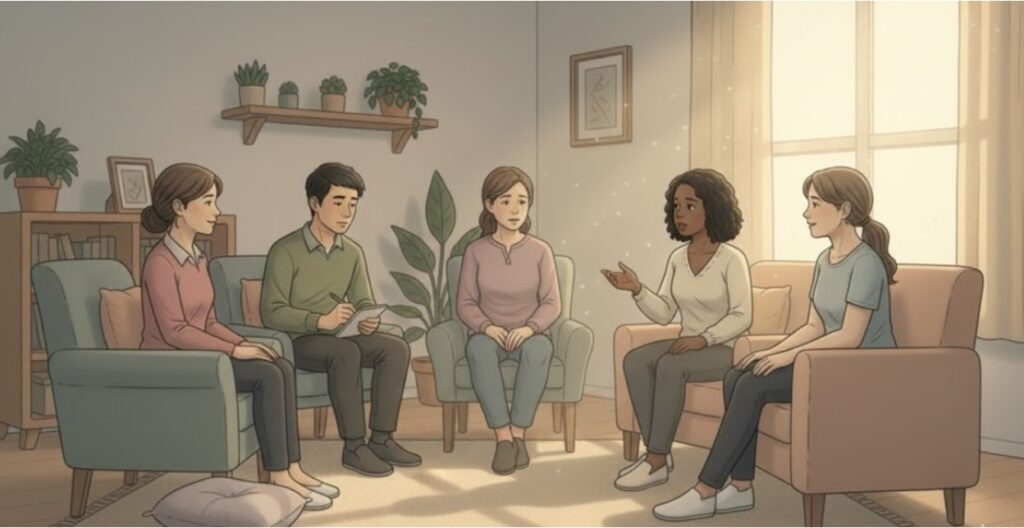Key Takeaways
- Emotional numbness in depression is persistent and mutes both positive and negative emotions, leaving people feeling isolated and disconnected from daily life and relationships.
- Physical signs often accompany numbness, including fatigue, heaviness, changes in sleep, or loss of appetite, reinforcing emotional withdrawal.
- Numbness differs from sadness: sadness is an active emotion, whereas numbness reflects a shutdown of the brain’s emotional response system, often linked to neurotransmitter changes and chronic stress.
- Recovery is gradual and involves gentle, consistent strategies such as reconnecting with meaningful activities, noticing subtle emotions, and reducing automatic numbing behaviors to rebuild emotional capacity.
- A Mission for Michael (AMFM) provides personalized, evidence-based care, combining therapies like CBT, DBT, and EMDR with compassionate guidance to help individuals safely regain emotional connection and rebuild a full, meaningful life.
How Emotional Numbness Shows Up in Depression
Depression-related numbness is more than occasional “blah” feelings. It’s a persistent emotional flatness where reactions fade, even in situations that would normally trigger strong feelings. This state can be as disabling as intense sadness, yet it’s often overlooked or misinterpreted as a lack of effort or engagement. Emotional numbness can quietly disrupt relationships, work, and daily life, leaving people feeling isolated even when surrounded by others.
Going Through the Motions
Many people with numbness describe themselves as “going through the motions” of daily life. You may attend events, complete work tasks, or care for family members, but these activities feel mechanical and empty. The emotional connection that usually brings meaning to these moments is missing. Both positive and negative feelings, joy, anger, grief can become muted, creating a strange limbo where life feels distant and surreal, as if you are a passive observer rather than an active participant.
The Gap Between Events and Emotions
A hallmark of depression-related numbness is the disconnect between what you should feel and what you actually experience. You might intellectually understand that a friend’s success is worth celebrating or that a sad movie is moving, yet your emotional response is absent. This gap can intensify feelings of guilt, frustration, or inauthenticity. Over time, people may avoid situations that highlight this disconnect, which can deepen social withdrawal and a sense of isolation.
Physical Signs of Emotional Flatness
Emotional numbness often manifests physically. Many experience heaviness in the limbs, fatigue that rest doesn’t relieve, or changes in sleep and appetite. Even food can lose its appeal, mirroring the emotional detachment. This mind-body disconnection makes daily tasks feel effortful and can reinforce the cycle of withdrawal, further deepening the emotional flatness.
Numbness vs. Sadness in Depression
Sadness is active and painful, a fully felt emotional state. Numbness, by contrast, is the absence of feeling, a shutdown of the brain’s emotional response system. Many people with depression shift between these extremes, sometimes overwhelmed by emotion, sometimes emotionally void. Recognizing this spectrum helps clarify the complexity of depression and why support must account for both ends of the emotional experience.
Founded in 2010, A Mission For Michael (AMFM) offers specialized mental health care across California, Minnesota, and Virginia. Our accredited facilities provide residential and outpatient programs, utilizing evidence-based therapies such as CBT, DBT, and EMDR.
Our dedicated team of licensed professionals ensures every client receives the best care possible, supported by accreditations from The Joint Commission and the California Department of Health Care Services. We are committed to safety and personalized treatment plans.
The Science Behind Feeling Numb
Emotional numbness isn’t just psychological. It has clear biological roots. Depression alters how the brain processes emotions, affecting neurotransmitters and the communication between brain regions. These changes don’t simply cause sadness; they can mute the entire emotional system, making life feel flat and disconnected.
Your Brain’s Self-Protection System
Numbness often develops as the brain’s way of shielding itself from emotional overload. Just as the body releases endorphins to dull physical pain, the brain can temporarily “shut down” emotional processing when stress or grief becomes too intense. This defense may help in the short term, but when it persists, it blocks both joy and sadness.
A study observed that PTSD patients showed altered brain activity during the recall of negative emotional narratives. Specifically, they maintained higher activation levels in the left amygdala and prefrontal cortex, suggesting potential regulatory issues in suppressing or diminishing fear memories.
Dopamine Depletion and Emotional Blunting
Depression disrupts neurotransmitters like dopamine, the chemical linked to pleasure, motivation, and reward. When dopamine levels drop, the brain’s reward system stops responding as it should. Things that once brought joy, music, food, and loved ones, no longer spark emotion. This chemical imbalance helps explain why depression feels like emotional emptiness rather than constant sadness.
How Stress Hormones Play a Role
Chronic stress floods the body with cortisol, which over time dulls emotional responsiveness, a state known as “stress-induced anhedonia.” Prolonged high cortisol can even alter brain structures like the hippocampus and prefrontal cortex, areas crucial for emotional regulation. These changes make it harder to access or express feelings, deepening the sense of numbness that often accompanies depression.
When Emotional Flatness Signals Something Deeper
Everyone feels emotionally flat sometimes after exhaustion, stress, or major changes. But depression-related numbness is different. It lingers, deepens, and starts to interfere with daily life and relationships, long after external stressors fade.
Duration: How Long Have You Felt This Way?
Normal emotional dullness usually lifts within a few days of rest or relief. Depression-related numbness, however, can persist for weeks or months, unaffected by positive changes. Mental health professionals often use a two-week threshold when assessing depressive symptoms, but with numbness, consistency across different situations is a key warning sign.
Impact on Daily Life and Relationships
When numbness affects work, motivation, and relationships, it signals something deeper. You might withdraw from loved ones, find social interactions draining, or struggle to care about things that once mattered. Relationships often suffer; most partners may feel shut out, misreading your numbness as disinterest, which can create distance and guilt on both sides.
Warning Signs That Need Immediate Help

Quality sleep plays a crucial role in mental and emotional recovery.
Emotional numbness can become dangerous when it’s joined by thoughts of death, hopelessness, or difficulty managing basic needs like eating or hygiene. These are signs of severe depression that require professional help right away. Reaching out for support is the first step toward feeling again.
Other Causes of Emotional Numbness
While depression is a common cause, emotional numbness can also stem from medication effects, trauma, chronic stress, or other mental health conditions. Identifying the root cause is key, as each requires a different approach to treatment.
Medication Side Effects
Ironically, antidepressants, especially SSRIs, can sometimes cause emotional blunting. Around half of users report feeling less emotionally responsive. These medications ease negative emotions but may also dampen positive ones, leaving a sense of emotional flatness.
Trauma Responses
After traumatic experiences, numbness can act as a survival mechanism. The brain temporarily shuts down emotional processing to prevent overload. In PTSD, this often alternates with flashbacks or emotional flooding.
Trauma-related numbness tends to appear suddenly and is triggered by reminders of the trauma, while depression-related numbness develops gradually and remains steady. Trauma treatment focuses on processing the original event, whereas depression therapy targets broader mood and thought patterns. Many people experience both, requiring integrated care.
Burnout and Chronic Stress
Long-term stress without recovery can lead to burnout marked by exhaustion, cynicism, and reduced motivation. Emotional numbness here develops as a defense against relentless pressure, mirroring the emotional shutdown seen in depression.
Other Mental Health Conditions
Emotional numbness can appear in disorders like schizophrenia (as “affective flattening”), dissociative disorders (emotional and self-detachment), and certain personality disorders where detachment is a long-standing trait. Even anxiety can cause temporary numbness when fear becomes overwhelming, the brain may shut down emotional responses altogether.
5 Ways to Break Through the Numbness
Recovering from emotional numbness takes patience and gentle consistency. The goal isn’t to force feelings but to create conditions where emotions can safely return. These small, research-backed steps can help you reconnect over time.
1. Create Small Emotional Connections Daily
Start small, watch a short, funny video, spend a few minutes with a friend, or listen to a song that once moved you. These mini emotional “workouts” rebuild your capacity to feel. Music is especially effective, activating multiple brain regions and helping rewire emotional pathways.

Group therapy provides a safe space for shared experiences and mutual support.
2. Move Your Body to Shift Your Brain Chemistry
Movement boosts mood-regulating chemicals like dopamine and endorphins. Even a 20-minute walk can lift emotional responsiveness. Activities that engage your senses, like walking in nature, dancing, or gardening, are particularly powerful. Focus on daily consistency, not intensity.
3. Practice Mindful Emotion Recognition
Numbness often means losing touch with the body’s emotional signals. Pause a few times a day to notice sensations like tightness, warmth, or heaviness. Journaling these subtle cues strengthens the link between physical and emotional awareness. Guided body scan meditations can help if tuning in feels difficult.
4. Reintroduce Meaningful Activities
Depression often leads people to stop doing things they used to enjoy. Start re-engaging in one meaningful activity, even if it doesn’t spark emotion at first. Approach it with curiosity rather than pressure, focus on the experience itself, not how you “should” feel.
5. Reduce Numbing Behaviors
It’s common to seek sensation through screen time, substances, or thrill-seeking when emotions feel out of reach. These quick fixes, however, deepen disconnection. Try to notice your numbing habits, pause before acting, and ask what emotion you’re really chasing. Gradually replace them with healthier ways to reconnect.
Professional Help for Emotional Numbness
Persistent emotional numbness often requires professional support. Depression and other conditions can alter brain function in ways that benefit from targeted interventions. A mental health professional can identify the root cause and tailor treatment to your needs. Early help typically speeds recovery and prevents numbness from becoming entrenched. Combining professional care with self-help strategies often yields the best results.
Therapy Approaches That Target Emotional Blunting
Different therapies address numbness through specific mechanisms:
- CBT (Cognitive-Behavioral Therapy): Identifies thought patterns that maintain numbness and gradually reintroduces emotionally engaging activities.
- ACT (Acceptance and Commitment Therapy): Builds flexibility to act toward valued goals even when emotions feel absent.
- EMDR / Somatic Approaches: Help process trauma-related frozen emotional responses in the nervous system.
- DBT (Dialectical Behavior Therapy): Teaches emotional awareness and regulation skills with mindfulness techniques.
When Medication Might Help (or Hurt)
Antidepressants can reduce depression symptoms but sometimes increase emotional blunting. If numbness existed before medication, antidepressants may restore emotional responsiveness by correcting neurotransmitter imbalances. If numbness worsens after starting medication, consult a prescriber about alternatives or dosage adjustments. Never change medication on your own.
A Mission for Michael (AMFM): Your Path to Emotional Reconnection

Comfortable, welcoming environments help create a sense of safety during treatment.
At AMFM, we understand that emotional numbness can feel isolating and overwhelming. Founded by a family who experienced the heartbreaking loss of their son, Michael, to mental illness, AMFM was established to ensure that no one has to walk the path of recovery alone.
AMFM provides personalized, evidence-based care designed to each individual’s needs. Our programs integrate therapies such as CBT, DBT, Eye Movement Desensitization and Reprocessing (EMDR), and integrated approaches including art, music, and animal-assisted therapies. The center provides a comprehensive continuum of care, from residential treatment to intensive outpatient programs, ensuring support at every stage of recovery.
Staffed by experienced Master’s and Doctorate-level clinicians, AMFM combines clinical expertise with compassion to guide individuals through the emotional reconnection process. With locations across California, Minnesota, and Virginia, AMFM is committed to making accessible, high-quality care available nationwide.
If you’re ready to take the first step toward reclaiming your emotional life, AMFM provides the support and guidance you need. Our dedicated team is ready to help you rebuild your capacity for feeling, connection, and well-being.
Frequently Asked Questions (FAQs)
Is emotional numbness always a sign of depression?
Not always. While common in depression, numbness can also occur in PTSD, anxiety, burnout, medication side effects, and dissociative disorders. When it started, accompanying symptoms, and whether it fluctuates or persists, help determine the cause. A professional assessment is the most reliable way to identify the source.
Can I have depression if I don’t feel sad but just feel nothing?
Yes. Many people with depression primarily experience numbness, emptiness, or apathy rather than sadness. Emotional numbness is recognized as a core symptom, especially in longer-lasting depressive episodes.
Why do antidepressants sometimes cause emotional numbness?
Antidepressants affect neurotransmitters that regulate both positive and negative emotions. While they reduce negative feelings, they can also dampen positive responses. If this occurs, consulting your provider about alternative medications or dosage adjustments can help restore emotional balance.
What’s the difference between emotional numbness and apathy?
Emotional numbness is a reduced capacity to feel, while apathy involves both diminished emotion and motivation. You might feel numb but still want to care, whereas apathy includes a lack of desire to engage. In depression, numbness can contribute to apathy over time.
How long does emotional numbness from depression last?
Without treatment, numbness can last weeks to years. With proper care, most people experience gradual improvement. Emotional responsiveness often returns in small increments, with brief moments of feeling that grow over time. Full recovery can take months, but many notice progress within weeks of starting a comprehensive program. Centers like A Mission for Michael (AMFM) provide structured, evidence-based treatment and supportive care designed to help individuals rebuild their emotional connection safely and effectively.












